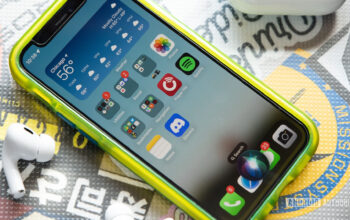Location Services is pretty much the bones of the iOS operating system. Privacy advocates will give you a long list of reasons why you should disable it, but in reality, a disabled iPhone Location Services is the equivalent of a very diminished experience on your device. Many apps and iOS features rely on Location Services, while other features could be seen as optional. Let’s take an overview of iOS Location Services and what you should enable or disable.
Read more: How to see your iPhone location history
QUICK ANSWER
Location Services can be found on an iOS device by going to Settings–>Privacy–>Location Services. Tap the toggle to green to enable it, and then enable or disable each individual sub-feature, depending upon your needs.
JUMP TO KEY SECTIONS
An overview of Location Services on iOS 15
Location Services is the area of your iOS device where you get to decide how much privacy you’re willing to give away to Apple and to app developers, in the interests of maximizing your iOS experience. That’s pretty much iPhone Location Services in a nutshell.
Every app and every Apple feature requiring the use of your location is listed here, and you can decide on a case-by-case basis whether or not to grant access to your current location. Or you can go full nuclear and disable Location Services entirely. But as I said, disabling it will greatly diminish your smart device experience. Many apps will either be severely crippled or not work at all.
Some of the downsides of disabling Location Services
- There would be no Google Maps or Apple Maps navigation.
- There would be no tracking of your lost or stolen devices and other items using Find My. Your AirTags would stop working.
- You couldn’t track your workout routes on Apple Watch.
- The Emergency Calls & SOS feature would not be able to give your location to Emergency Services.
- Your camera would not be able to attach metadata to each photo.
- You wouldn’t get the weather forecast for your area.
- Location-based reminders would stop working. So no remembering to get the milk when you drive past the supermarket.
- Elements of HomeKit will stop working if it can’t tell if you’re almost home or actually home.
- Automatic timezone changing won’t work, which would be hugely inconvenient for frequent travelers, and some apps such as two-factor authentication won’t work if the times are not synced properly.
These examples are only just scratching the surface of what you would be missing out on if you disabled Location Services. So it’s worth enabling it and only using what you need to use.
How to turn iPhone Location Services on and off
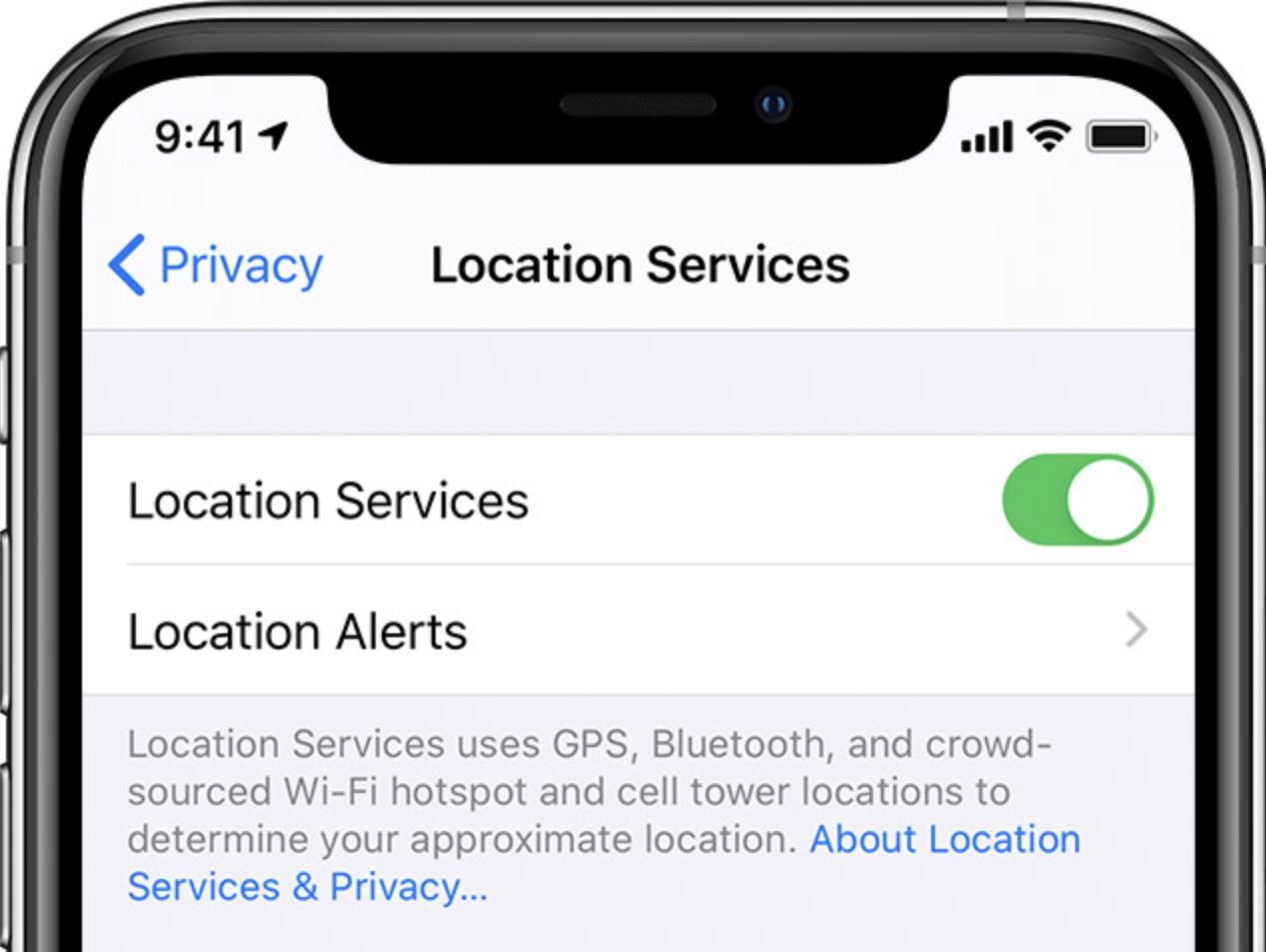
When you’re setting up an iOS device for the first time, it will ask you, as part of the setup process, if you want to activate Location Services. If you choose not to at that stage, or if you subsequently disable it, you can enable it again by going to Settings–>Privacy–>Location Services. Toggle it to green, and that’s it turned on.
How to customize iPhone Location Services
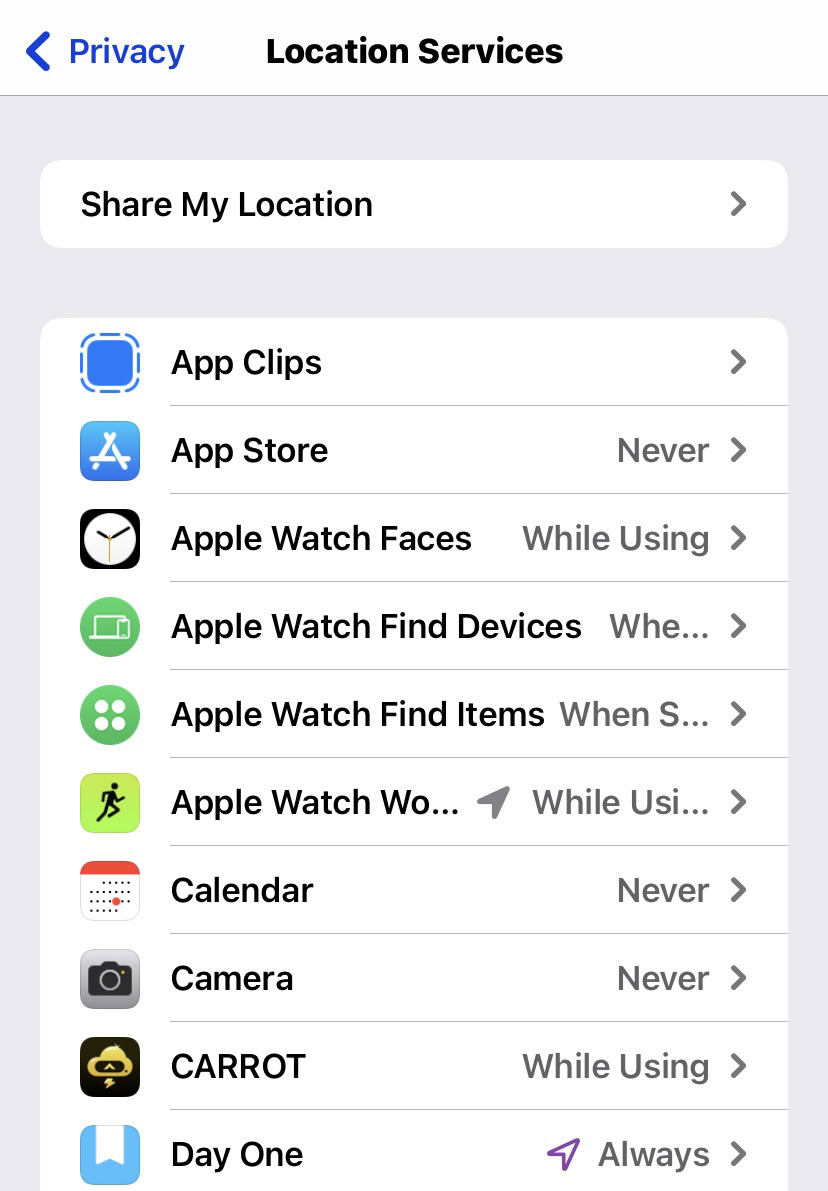
Let’s now look at the main settings page for iPhone Location Services and what each item does. You can then make your own judgment call as to whether or not you enable it or disable it. Of course, we will also be making recommendations.
Share My Location
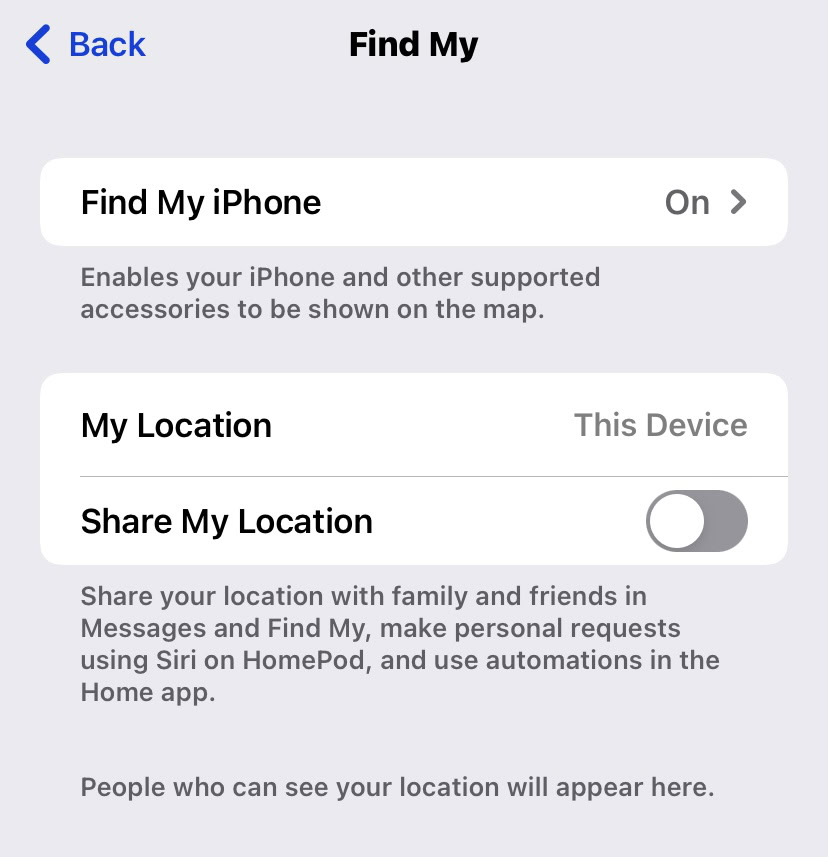
When you first tap Share My Location, you will see this is the home of Find My iPhone. At the very least, you should have Location Services turned on for this. An iPhone is an extremely expensive gadget — if it goes missing or is stolen, having Find My iPhone disabled is going to destroy any remaining chance you have of getting your phone back.
This is also the area where you can opt whether to share your current location with friends or family, or for the purposes of using Siri or the Home app. You have to approve each request manually, so you have complete control over this. However, some people may find it a bit intrusive if their family and friends can track their every move. Which is why I have it permanently switched off.
My Location is when you have more than one Apple device — you can select which device should be used to determine your location. If you carry one device more than another, you can switch to that device for location tracking purposes.
Find my iPhone
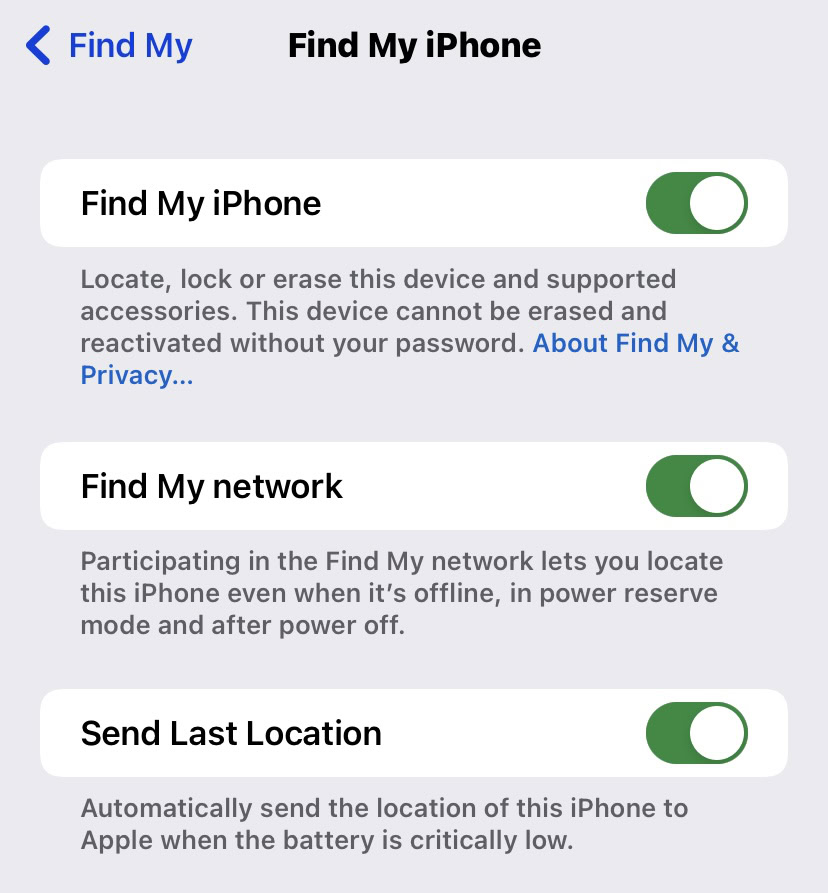
Toggle on Find My iPhone and follow the on-screen instructions, including entering a passcode. The passcode stops a thief from turning the Find My feature off and from entering a new SIM card into the phone. Note that if you want to reset your iPhone, you will have to switch Find My iPhone off, otherwise a new owner will not be able to use it. It’s very easy to overlook.
Using Find My iPhone also allows you to remotely wipe your device if it is stolen, so your personal data remains safe. You can also find the device when it has been switched off or offline (in Airplane Mode, for example.)
Customize permission levels for specific apps
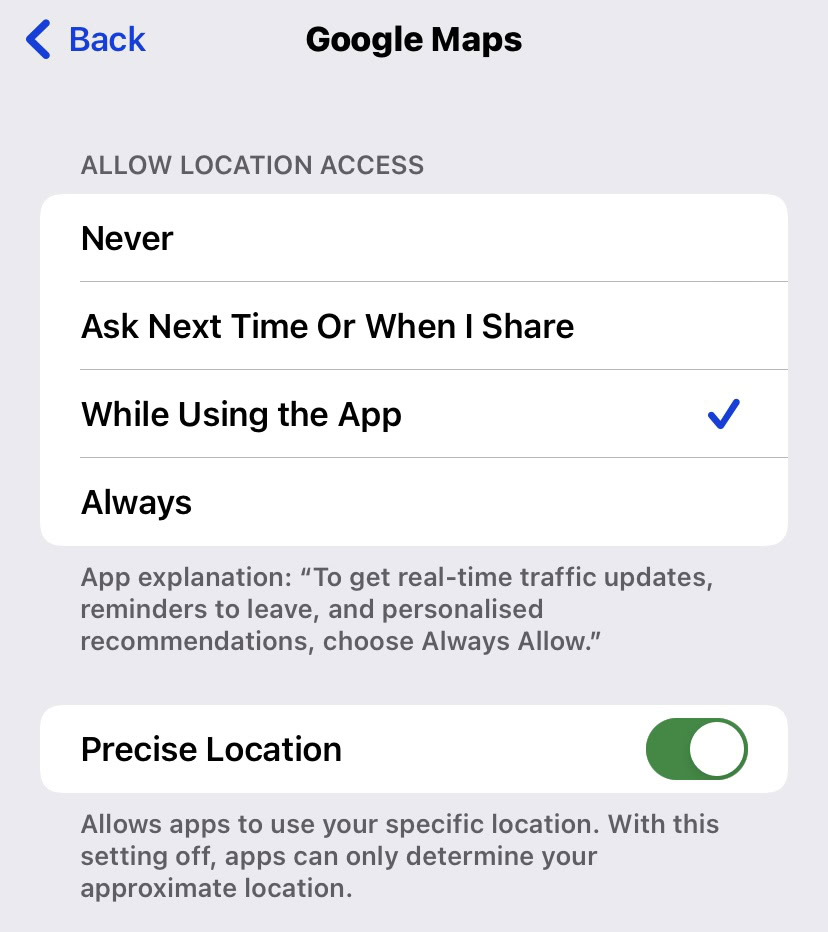
If you now go back to the main Find My iPhone screen, you will see your installed apps that require your location. You can choose to either give them permanent access, access only when the app is being used, or no access at all. The screen will tell you why the app is requesting your location information, and it’s up to you to decide if it sounds legitimate or not.
You should always be very careful, though, and err on the side of caution. If you do grant access to your location, the best one is While Using the App. Not only does this restrict how much location data the app can collect, but it is also less of a drain on your phone battery. Some apps also request your data when there is no earthly reason why they would need it. For example, apps like Shazam, DropBox, and PayPal do not need your location details, no matter how much they say they do.
Google Maps or Yelp, on the other hand — well, that’s a different story. Plus, you may want location tracking for social media apps to tag you correctly. It’s all a matter of common sense and what your needs are.
Remember, any decision you make can be easily and immediately revoked later. Nothing is forever.
iOS System Services
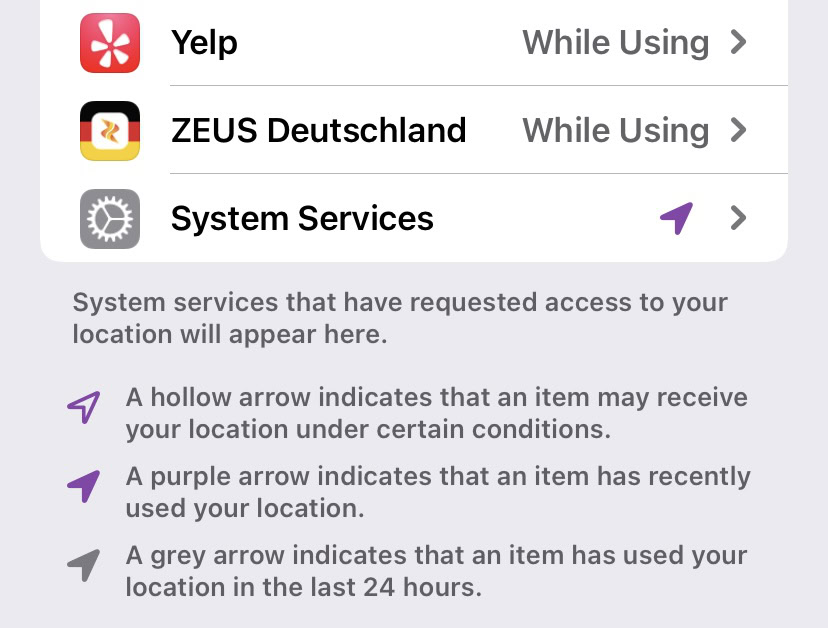
The next big area to look at is System Services, which is further down the Location Settings page. This opens up another big can of worms that you should carefully review. Here, Apple very helpfully puts the meaning of the little diagonal arrows which you will see next to apps and settings wanting your location. At a glance, you can see which apps and settings are most hungry for your location data. Tap System Services to proceed to the next screen.
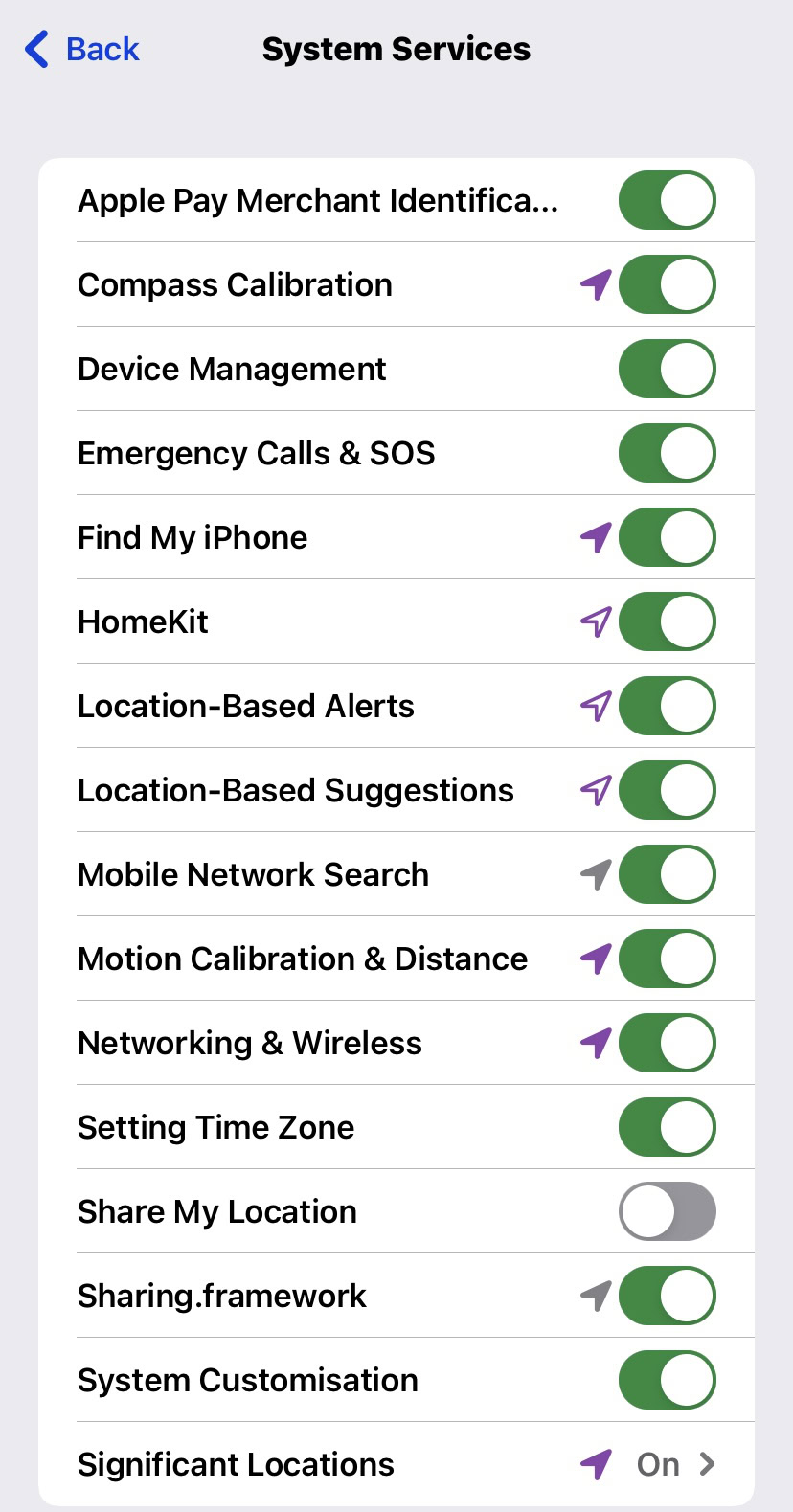
A lot of this stuff is safe to disable if you want. Again, it all comes down to what you need. Let’s look at each one in turn. Click on one to drop down details on it.
iOS System Services options
Only useful if you have a physical Apple Card. It uses your current location to provide more accurate merchant names. Disable if you don’t have an Apple Card.
Uses location tracking to help calibrate the Compass app. Disable if you don’t use the Compass app.
Configures Apple devices by sending profiles and commands to them, whether they’re owned by the user or your organization. You can pretty much disable this.
Allows the iPhone user to call 911 and use location data to pinpoint their exact location. This one is recommended.
Enables an iOS device owner to track their lost or stolen device. Highly recommended.
Apple’s smart home platform, which can do things like turning on lights, telling Siri via HomePod to play music, and more. This can be disabled if you don’t use HomeKit.
Apple will use your location to give you what it considers to be useful information, based on where you are. This can be something like a severe weather warning, for example. I keep this on, but it really all depends on how far and often you travel from home.
Based on your location, you may get movie theater recommendations from Spotlight and Siri, for example, as well as directions to nearby highly-rated restaurants. Again, you can decide if you will get any use out of this.
Called Cell Network Search in the US, it tracks your usage of cell towers. I recommend switching this one off.
This is only necessary if you need to measure your exercise and steps on fitness apps or an Apple Watch. If you don’t use these, you can disable it.
Tracks Wi-Fi usage. Recommend this one be disabled, although you will get a warning from Apple that it could potentially affect your Bluetooth and Wi-Fi.
Self-explanatory, the name says it all. When you cross into a different timezone, Apple will automatically adjust the time on your phone. Very convenient for frequent travelers, but also good for daylight savings time adjustments. But you could just as easily manually change it.
As we have already seen, this allows you to share your real-time location with people on platforms such as iMessage. I see this as very intrusive and have it disabled.
This is a technical setting and can be disabled. However, some Reddit users have reported that it switches itself back on again a day or two later. So you need to watch this one.
Apparently, it changes the look and feel of your iOS device, as well as settings, based on your location. Recommend this one is turned off.
Collects together all of the places you usually frequent. Again, too intrusive in my view, so I have it switched off.
Sends your iPhone usage data to Apple. Definitely disable this one.
Shares your travel routes and details of those routes (such as traffic and accidents) to improve Apple Maps. This is one you can decide on based on your likely usage, but I personally have it turned off.
Uses your current location to improve Maps by improving the estimated time of arrivals to various destinations. Again, entirely at your discretion.
An iPhone can only be tracked to the last location before the phone was switched off. Assuming this is not your current location, someone will not be able to track you and your device again until the device is switched back on again.
No, Google Maps and Apple Maps require your precise location to be able to give you turn-by-turn directions.
Apple estimates that if you are in an area with strong satellite coverage, Find My iPhone is accurate to within 20 feet.

